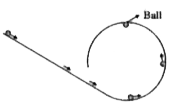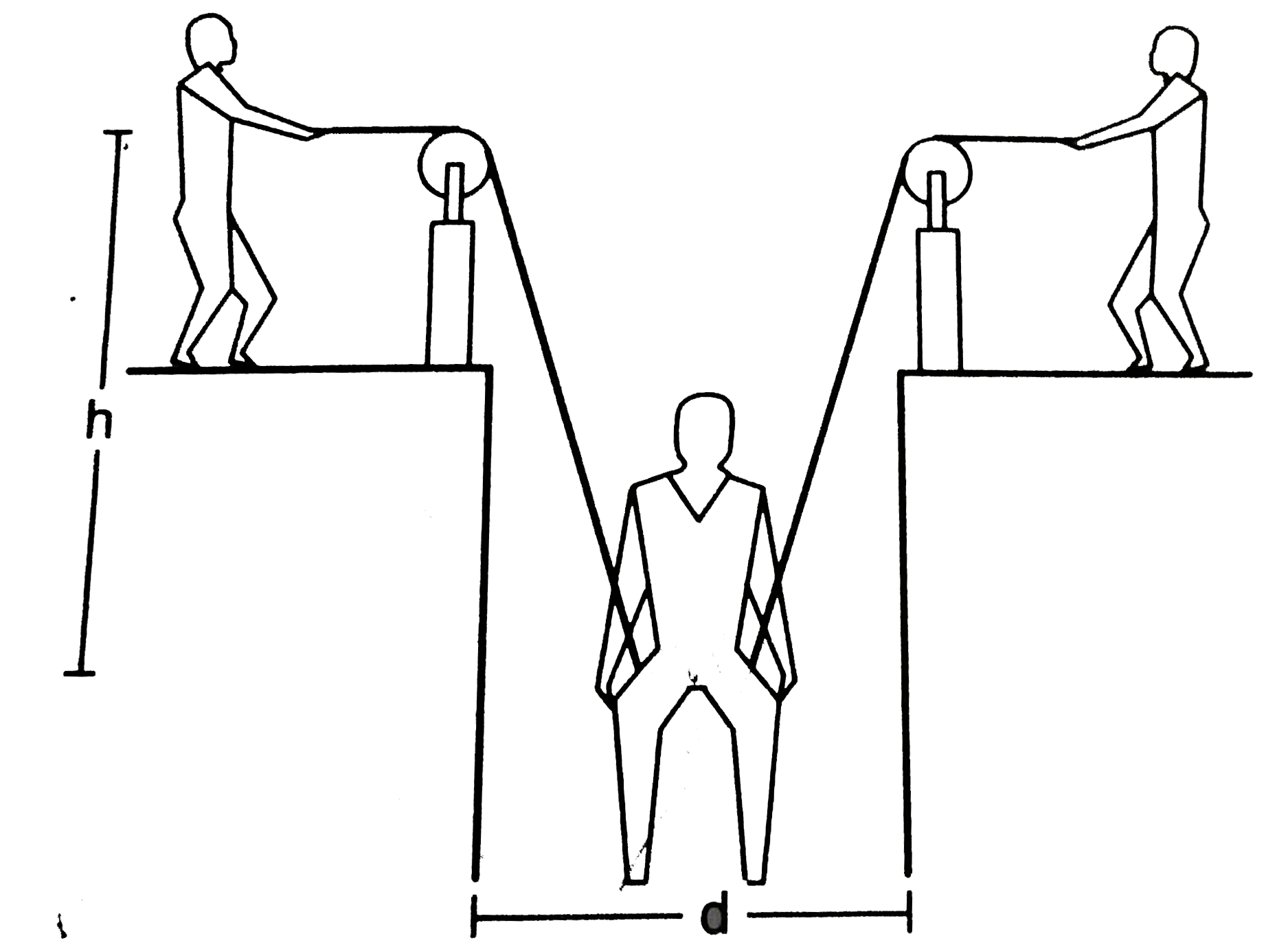A pilot of mass 70 kg in a jet aircraft moves in a vertical circle while executing the loop-the-loop at a constant speed of 200 m/s. If the radius of the circle is 2.5 km what is the force exerted by the seat on the pilot at (a) the top of the loop and (b) the bottom of the loop.
To solve the problem, we need to calculate the force exerted by the seat on the pilot at two points in the loop: at the top and at the bottom of the loop.
Given Data:
- Mass of the pilot (m) = 70 kg
- Speed of the aircraft (v) = 200 m/s
- Radius of the loop (r) = 2.5 km = 2500 m
- Acceleration due to gravity (g) = 9.8 m/s²
Step 1: Calculate the centripetal force required at the top of the loop.
At the top of the loop, the forces acting on the pilot are:
- Weight (mg) acting downwards.
- Normal force (N1) exerted by the seat acting downwards.
The net force providing the centripetal acceleration (Fc) is given by:
Fc=N1+mg
The centripetal force can also be expressed as:
Fc=mv2r
Setting the two expressions for centripetal force equal gives:
N1+mg=mv2r
Rearranging for N1:
N1=mv2r−mg
Step 2: Substitute the values to find N1.
Substituting the known values:
- m = 70 kg
- v = 200 m/s
- r = 2500 m
- g = 9.8 m/s²
N1=70⋅(200)22500−(70⋅9.8)
Calculating:
1. Calculate 70⋅(200)22500:
=70⋅400002500=28000002500=1120N
2. Calculate 70⋅9.8:
=686N
Now substitute back:
N1=1120−686=434N
Step 3: Calculate the force exerted by the seat on the pilot at the bottom of the loop.
At the bottom of the loop, the forces acting on the pilot are:
- Weight (mg) acting downwards.
- Normal force (N2) exerted by the seat acting upwards.
The net force providing the centripetal acceleration is given by:
Fc=N2−mg
Setting the two expressions for centripetal force equal gives:
N2−mg=mv2r
Rearranging for N2:
N2=mv2r+mg
Step 4: Substitute the values to find N2.
Using the same values as before:
N2=70⋅(200)22500+(70⋅9.8)
We already calculated 70⋅(200)22500=1120N and 70⋅9.8=686N.
Now substitute back:
N2=1120+686=1806N
Final Answers:
(a) The force exerted by the seat on the pilot at the top of the loop is approximately 434 N.
(b) The force exerted by the seat on the pilot at the bottom of the loop is approximately 1806 N.
- Mass of the pilot (m) = 70 kg
- Speed of the aircraft (v) = 200 m/s
- Radius of the loop (r) = 2.5 km = 2500 m
- Acceleration due to gravity (g) = 9.8 m/s²
- Weight (mg) acting downwards.
- Normal force (N1) exerted by the seat acting downwards.
Fc=N1+mg
Fc=mv2r
N1+mg=mv2r
N1=mv2r−mg
- m = 70 kg
- v = 200 m/s
- r = 2500 m
- g = 9.8 m/s²
1. Calculate 70⋅(200)22500:
=70⋅400002500=28000002500=1120N
=686N
N1=1120−686=434N
- Weight (mg) acting downwards.
- Normal force (N2) exerted by the seat acting upwards.
Fc=N2−mg
N2−mg=mv2r
N2=mv2r+mg
N2=70⋅(200)22500+(70⋅9.8)
N2=1120+686=1806N
(a) The force exerted by the seat on the pilot at the top of the loop is approximately 434 N.
(b) The force exerted by the seat on the pilot at the bottom of the loop is approximately 1806 N.
Topper's Solved these Questions
- CIRCULAR MOTION Book:ICSEChapter:CIRCULAR MOTION Exercise:MODULE 1 (CONCEPTUAL SHORT ANSWERS QUESTIONS WITH ANSWERS )
Explore 11 Videos
- CIRCULAR MOTION Book:ICSEChapter:CIRCULAR MOTION Exercise:MODULE 1 (LONG ANSWER QUESTIONS)
Explore 8 Videos
- COMPETITION CARE UNITBook:ICSEChapter:COMPETITION CARE UNITExercise:OBJECTIVE QUESTIONS FROM PREVIOUS IAS EXAMINATIONS
Explore 50 Videos
Similar Questions
A ball of mass 100 g is made to loop-the-loop in a vertical circle as shown in Fig. 7.1.29. The radius of the circle is 0.5 m (i)-What is the critical velocity at the highest point of the track ? (ii) If the velocity of the ball at the highest point of the track is twice the critical velocity what is the force exerted by the ball against track?

View SolutionThe elevator shown in figure is descending with an acceleration of 2ms2. The mass of the block A is 0.5 kg. What force is exerted by the block A on the block B?

View SolutionAt what point does a pilot in an aeroplane appear to be heaviest while performing a loop-the-loop in a vertical plane.
View SolutionA body of mass m is moving in a circle of radius r with a constant speed v, The force on the body is mv2r and is directed towards the centre what is the work done by the from in moving the body over half the circumference of the circle?
View SolutionAn aircraft executes a horizontal loop at a speed of 200m/s with its wings banked at 15°. What is the radius of the loop ?
View SolutionAn aircraft executes a horizontal loop at a speed of 540 km/h with its wings banked at 45∘. What is the radius of the loop?
View SolutionA stone of mass of 1 kg is tied to the end of a string 1 m long. It is whirled in a vertical circle. The velocity of the stone at the bottom of the circle is just sufficient to take it to the top of circle without slackening of the string. What is the tension in the string at the top of the circle? (Take, g =10 ms−2)
View SolutionFor a particle rotating in a vertical circle with uniform speed, the maximum and minimum tension in the string are in the ratio 5 : 3. If the radius of vertical circle is 2 m, the speed of revolving body is (g=10m/s2)
View SolutionA body is moving in a circle with a speed of 1ms−1. This speed increases at a constant rate of 2ms−1 every second. Assume that the radius of the circle described is 25m. The total accleration of the body after 2s is.
View SolutionAn aircraft executes a horizontal loop at a speed of 720kmh−1, with its wings banked at 15∘ What is the radius of the loop ?
View Solution
